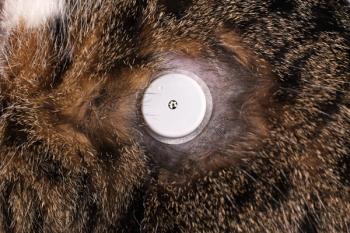
How I manage endocrine cases (Proceedings)
Information on thyroid function, pituitary pars intermedia dysfunction, and equine metabolic syndrome in horses.
Thyroid Function
- ↑ mitochondrial number and size
- ↑activity of Na,K-ATPase
- 15% to 40% of your Basal Energy
- Increased energy expenditure of the cell
- ↑protein synthesis and catabolism
- ↑ heat production
- Stimulate basal metabolic rate
Thyroid Function in the Fetus/Neonate
- ↑ mental activity and neural development
- ↑ lung maturation
- ↑ gastrointestinal function
- ↑ cardiovascular function
- ↑ growth and maturation of the skeletal system
Hypothyroidism
Primary
Secondary / Tertiary
- Problem with conversion of T4 to T3 in peripheral tissues
- TSH
- TRH
"False" (Non-thyroidal Illness)
Hyperthyroidism
Factors Affecting Thyroid Levels
Physiologic/pathologic influences
- NSAID administration
- Decrease levels for 2 weeks!
- Corticosteroid administration
- High energy or protein diets
- > 30% of Diet Concentrate levels will decrease
- > 50% then levels decrease to very low levels
- High zinc or copper diets
- Food deprivation
- High intensity exercise
- Non-thyroidal illness syndrome
What DVM's associate with low thyroid levels
- Anhidrosis
- Alopecia
- Chronic Laminitis
- Infertility
- Obesity
- Orthopedic disease
- Congenital hypothyroidism/dysmaturity syndrome
Thyroidectomized horses
- Retarded growth
- Increased sensitivity to cold
- Edema of lower legs
- Decreased feed consumption
- Weight loss
- Decreased Cardiac Output
- Increased blood/plasma volume
Non Thyroidal Illness
- Low thyroid levels to help decrease metabolic rate
- Conservation of lean mass
- Decreased conversion of T4→T3
DIAGNOSTICS
- Rule out other diseases
- Sick euthyroid
- Free T4/T3 and Total T4/T3
- Free T4 either by Dialysis or Diasorin two
- IF fT4 and fT3 are normal→ Not hypothyroid
- Even IF Total T4 and T3 are low
- If fT4 and fT3 are low then:
- Repeat test / Rule Out Sick euthyroid
- Perform TRH stimulation test
- TRH Stimulation Test
- No sterile medical preparation available
- 1mg IV Horse
- 0.5 mg IV Pony
- Pre-Sample
- Post Sample 2 hours Post
- Look for peak in T3
- Response to Treatment
Treatments
- Thyro-L
- Highest MRD 0.08 mg/kg
- Minimal Increases of T4 Levels
- Double MRD
- 100% increase in T4 levels
- Treat for 4-6 weeks and re-test if OK
- Decrease to MRD
- Routinely do PE and hormone levels every 2-4 months
Pituitary Pars Intermedia Dysfunction (PPID)
- Pituitary Gland
- Pars distalis (Anterior Lobe)
- Somatotrophs: growth hormone
- Lactotrophs: prolactin
- Thyrotrophs: Thyroid Stimulating Hormone
- Gonadotrophs: FSH, LH (or ICSH)
- Corticotrophs: prohormone proopiomelanocortin (POMC) cleaved to ACTH & LPH
- Pars intermedia (Intermediate Lobe)
- Melanotropes: Melanocyte Stimulating Hormone
- POMC→ β-Endorphin,ACTH and α – MSH
- ACTH= 2% of Posttranslation
- Pathogenesis (McFarlane 2006)
- Oxidative damage in the Hypothalmus
- Dopamine metabolism produces free radicals
- Loss of dopaminergic innervation to the PI
- Increased levels of ACTH, α – MSH , β-Endorphin
- α – MSH and β-Endorphin
- Six fold increase in the steroidogenic properties of ACTH
- Increased ACTH
- Increased Cortisol Concentrations
- Loss of Circadian Cortisol Concentrations
- Melanotropes
- Insensitive to glucocorticoid feedback
- Corticotrophs are SENSITIVE to feedback
- Breed Predilection
- Morgan and Pony Breeds
- Can occur in any breed
Clinical Signs
- Hirsutism
- Most common clinical sign
- Pathogenesis?
- Polyuria/Polydipsia
- Hyperhidrosis
- Chronic Laminitis
- Any older horse (> 13 yrs of age) that develops insidious onset of laminitis should be evaluated for PPID
- Chronic Infections
- Exercise Intolerance
Diagnostics
- Hirsutism
- Over the fence diagnosis
- Most accurate way to assess PPID
- So why do testing on these animals?
- Monitor response to treatment
- Unfortunately does not occur until later on in the disease process
- Endocrine Testing
- Some are controversial
- Dexamethasone Suppression Test
- Look for Suppression of endogenous Cortisol
- After giving 2mg/100 pounds of Dexamethasone IM
- Give late afternoon (4pm or 5pm)
- Take 2nd sample between 10am and noon
- < 1µg/dl by 19 hours
Dexamethasone Suppression Test
- Do not like to do in hospital setting
- Seasonal Variation
- September to December(Donaldson JVIM 2005)
- Hypothalamic pituitary axis is very active
- Metabolically prepare for the winter?
- Decreased availability of food during the winter
- Increased weight gain/ Fat deposition
- Accurate with early disease?
ACTH Plasma Levels
- Looking for Elevations greater than the reference range for you lab
- ELEVATION: Supportive of PPID
- Magnitude DOES NOT EQUAL Severity
- Single Sample Test!
- Sample Handling
- Needs to be cooled
- Protein can degrade if warm
- Seasonal Variation (Donaldson JVIM 2005)
- Sept-Dec
Diurnal Cortisol Level
- Promoted by BET laboratory
- NO DATA provided by Peer Review
- Too much variability
- I DO NOT ADVOCATE THIS TEST
Dexamethasone and TRH Stimulation
- Time Consuming
- Accuracy 81%
- Histological Findings on 42 Horses
- DST 71%
- Good test for earlier stages of the disease?
Dexamethasone and TRH Stimulation
- FIRST
- Give Dexamethasone 2mg/100 pounds IM
- Suppresses Cortisol to "base line" level
- Similar between PPID and normal horses
- SECOND
- 3 hours later give 1mg TRH IV
- Samples
- Time 0 : Before TRH is given
- 30 Minutes after TRH is given
- 66% increase of Cortisol is suggestive of PPID
- 24 hours after TRH
- Lack of suppression of cortisol
- < 1µg/dl
Fasting Insulin Testing (Dr. Schott)
- Insulin Resistance
- Long term Prognosis = GUARDED
TRIAL and ERROR
- "Early PPID"
- Vague clinical signs
- Poor performance
- Tender Feet
- Diagnostic Dilemma
Treatments
- MANAGEMENT
- Foot Care
- Clip Hair
- Nutritional Consult?
- Equine Senior Feeds
- High fiber feeding
- Frequent fecal egg counts
- Intermittent antibiotic administration
- Medical
- Will early intervention prolong my horse's life?
- NO DATA EXISTS
- Does it need to be continuous or intermittent?
- Long term longitudinal studies would be needed
- My horse is in a Fescue Field, do I need to tx?
- May contain alkaloids that are dopamine-mimetic agents
- I still would Tx if clinical signs are persistent
- PERGOLIDE
- FIRST ROUND CHOICE (Donaldson JVIM 2002)
- Best treatment response from 3 independent studies
- SID
- 2-6µg/kg PO SID (1mg for 500kg horse)
- Anorexia?
- Decrease dose to 0.5 mg orally for 1-2 weeks and then increase to 1mg
- NO PK studies! In horses or humans!!
- Compounding vs Non Compounding
Treatments
- PERGOLIDE
- Response: 30-60 days
- Give at least 6 weeks
- Retest in 90 days
- DST
- Per Schott : Only 30% will show normalization
- ACTH
- Cyproheptadine
- Anti-serotonin
- Serotonin = Secretagogue of ACTH
- Anti-histamine
- 0.3 mg/kg PO BID
- POOR CLINICAL RESPONSE
- Combined with Pergolide
- Will work for some cases
- Vitamin E
- Antioxidant
- 5,000 to 10,000 IU Orally SID
Equine Metabolic Syndrome
- Criteria
- Insulin Resistance
- Prior or current laminitis
- Subclinical laminitis
- Obesity
- Regional Adiposity
- Pre Laminitic Metabolic Syndrome (Dr. Geor)
- Genetic Factors
- "Thrifty" genes →Easy Keeper
- Survival through periods of harshness
- Natural selection/survival of the fittest
- IR and Pro-inflammatory state before harsh winter
- Ossabaw Island Pigs
- Spanish Colonists
- Environmental Factors
- NSC in the pasture
- Over feeding → Iatrogenic
- INSULIN
- Released from the pancreas and helps drive glucose into the cells
- Major sites for insulin mediated glucose uptake (GLUT 4 transport proteins)
- Skeletal Muscle
- Adipose Tissue
- INSULIN Resistance
- Failure of the Skeletal muscle or Adipose Tissue to respond appropriately to insulin
- Compensated Insulin Resistance (Common)
- Example: Insulin has 1/2 of its normal effect→ Pancreas will respond→ MORE INSULIN
- Normal "Net Effect"
- Uncompensated Insulin Resistance (Uncommon)
- Pancreas "fails"
- Glucose levels start to rise
- Diabetes Mellitus : Rarely noted (Advanced PPID?)
- Not all obese horses have an endocrine disorder
- Mismanaged(Feeding)
- Feeding grain
- Stalled without turnout
- Overestimated significance of "work"
- Owner is "at fault"
- Too much energy in ration = fat
- Genetically Predisposed
- Middle Aged Obese Horses
- Pony's
- Morgans
- Paso Finos
- Saddlebreds
- Norwegian fjords
- Tennessee Walkers
- Arabs
- QH
- Typical Signs
- Laminitis
- Obesity
- Infertility
- Confused with Cushings
- Confused with "hypothyroidism"
Fat acts like a GLAND
- Adipokines (> 100 described)
- Reistin
- Leptin
- Obese horses noted elevations
- "Leptin Resistance"
- IL-6
- TNF alpha
- Oxidative stress → Cushing's?
- Cortisol
Omental Adipocytes → Special
- Produce numerous "hormones"
- 11β-hydroxysteroid dehydrogenase-1
- Converts Cortisone→Cortisol (Locally)
- Adipogenesis→IR
- Net activity is greater during obesity
- Glucocorticoids tend to provoke MORE adipocytes to express MORE 11β-HSD-1
Insulin Resistance
- Interference with insulin action at targets
- Enhanced stimulation for pancreatic insulin production (hyperinsulinemia)
- Insufficient glucose delivery to target cells
- Too much glucose for cells that do not depend on insulin (endothelial cells)
Insulin Resistance
- CAUSES
- Genetic variance
- Glucocorticoids
- Obesity →adipokines
- Stress
- Inflammation (cytokines)
- Dietary factors
- Mineral/micronutrient imbalances
- Supplements (glycosaminoglycans) (Dr. Messer)
Consequences
- Laminitis
- PPID →Oxidative Stress
- Thyroid Function
- Incr. Cortisol will Decr TSH production
- Chronic Inflammatory State→ Ox. Stress
- Rhabdomyolysis???
- Muscle cells and Glucose uptake
- OCD/Osteoarthritis
Insulin Resistance And Laminitis
- Endothelium is an organ with a mass equivalent to that of the liver
- Subjected to high levels of glucose
- Glucotoxicity → Oxidative stress
Insulin Resistance : What we learned
- Glucotoxic endotheliopathy
- Vasospasticity
- Oxidative stress
- Pro-inflammatory effects
- Impaired capillary recruitment
- MMP-9 expression
- Glucose starvation/deprivation
DIAGNOSTICS
- FASTING INSULIN
- Take off food 12 hours
- Measure Insulin Levels > 30 µU/mlSuggestive
- NEED TO REDUCE STRESS!
- Stress can induce insulin resistance
- Grass Hay If needed to quiet horse
- Minimal Glycemic Index
- Combined Glucose-Insulin Test
- Dynamic Test
- Detect Early Cases?
- 150 mg/kg 50% dextrose Drip
- Give 0.1 units/kg of regular Insulin
- After dextrose (immediate)
- BETTER HAVE EMERGENCY DOSE OF GLUCOSE
- Combined Glucose-Insulin Test
- Spike of Glucose
- Back to base line by 45 minutes
- Take Glucose Levels
- Pre-Sample
- 1,5,25,35,45 Minutes
TREATMENT
- Diet Changes
- Remove Concentrates
- Reduce access to lush pasture
- Morning grazing
- DO NOT GRAZE AFTER FROST
- 5,000 – 10,000 IU Vitamin E?
- CONSULT A NUTRITIONIST
- Magnesium Oxide
- Shown to be effective in rats and humans
- NOT SHOWN TO BE EFFECTIVE IN THE HORSE
- Chromium
- No Data to say it is efficacious?
- APF and Metformin?
TREATMENT
- Thro-L
- 4 teaspoons 1x daily for 1-2 months and then try to decrease
- Use as a metabolic Stimulant (Some clients have used it for 6-8 months)
- Can use oats to mix in (Low glycemic index)
TREATMENT
- Podiatry
Newsletter
From exam room tips to practice management insights, get trusted veterinary news delivered straight to your inbox—subscribe to dvm360.




